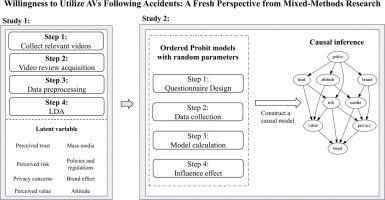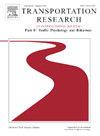事故发生后使用自动驾驶汽车的意愿:混合方法研究的新视角
IF 3.5
2区 工程技术
Q1 PSYCHOLOGY, APPLIED
Transportation Research Part F-Traffic Psychology and Behaviour
Pub Date : 2024-10-09
DOI:10.1016/j.trf.2024.09.022
引用次数: 0
摘要
虽然自动驾驶汽车(AVs)前景广阔,但在其实施过程中仍存在一些挑战。在这方面,负面事件会改变公众对这一技术的看法和接受程度。本研究使用潜狄利克特分配(LDA)、随机参数有序概率模型和结构因果模型来调查公众对自动驾驶汽车事件的担忧及其对公众采用自动驾驶汽车意愿的影响。本研究利用 LDA 分析大众媒体数据,确定了与自动驾驶汽车事件相关的七个潜在变量。为了考虑事件发生后公众态度的变化,态度被引入为一个新的潜变量。使用随机参数有序概率模型分析了各种变量对公众使用电动汽车意愿的影响。研究结果表明,感知信任、态度、感知风险、大众传媒、感知价值、品牌效应、隐私问题和政策法规是影响人们采用自动驾驶汽车的关键因素。随后,建立了一个因果结构模型,以确定变量之间的相互关系。模型显示,政策干预使公众采用自动驾驶汽车的意愿提高了 28%,这表明政策制定者的干预有助于为自动驾驶汽车创造早期市场。此外,良好的品牌推广和大众媒体宣传也会影响公众的心理特征,鼓励他们使用自动驾驶汽车。这些研究结果对减轻负面事件的负面影响、促进公众接受度具有重要意义,并为从理论上理解和实际使用自动驾驶汽车提供了有价值的见解。本文章由计算机程序翻译,如有差异,请以英文原文为准。

Willingness to utilize autonomous vehicles following accidents: A fresh perspective from mixed-methods research
While autonomous vehicles (AVs) show promise, several challenges remain in their implementation. In this regard, adverse incidents can alter public perceptions and acceptance of this technology. This study used latent Dirichlet allocation (LDA), a random-parameters ordered probit model and a structural causal model to investigate public concerns regarding AV incidents and their influence on the public’s willingness to adopt AVs. Using LDA to analyse mass media data, this study identified seven latent variables related to AV incidents. To consider changes in public attitudes following incidents, attitude was introduced as a new latent variable. The impact of various variables on public willingness to use AVs was analysed using a random-parameters ordered probit model. The findings indicated that perceived trust, attitude, perceived risk, mass media, perceived value, brand effect, privacy concerns and policies and regulations are crucial factors influencing AV adoption. Subsequently, a causal structure model was developed to determine the inter-relationships between variables. The model indicated that policy interventions increased public willingness to adopt AVs by 28%, suggesting that policymakers’ interventions help create an early market for AVs. In addition, good branding and mass media campaigns influence the public’s psychological characteristics and encourage the use of AVs. These findings hold crucial implications for mitigating the negative impacts of adverse incidents, fostering public acceptance and providing valuable insight for theoretical understanding and practical implementation of AV usage.
求助全文
通过发布文献求助,成功后即可免费获取论文全文。
去求助
来源期刊
CiteScore
7.60
自引率
14.60%
发文量
239
审稿时长
71 days
期刊介绍:
Transportation Research Part F: Traffic Psychology and Behaviour focuses on the behavioural and psychological aspects of traffic and transport. The aim of the journal is to enhance theory development, improve the quality of empirical studies and to stimulate the application of research findings in practice. TRF provides a focus and a means of communication for the considerable amount of research activities that are now being carried out in this field. The journal provides a forum for transportation researchers, psychologists, ergonomists, engineers and policy-makers with an interest in traffic and transport psychology.

 求助内容:
求助内容: 应助结果提醒方式:
应助结果提醒方式:


